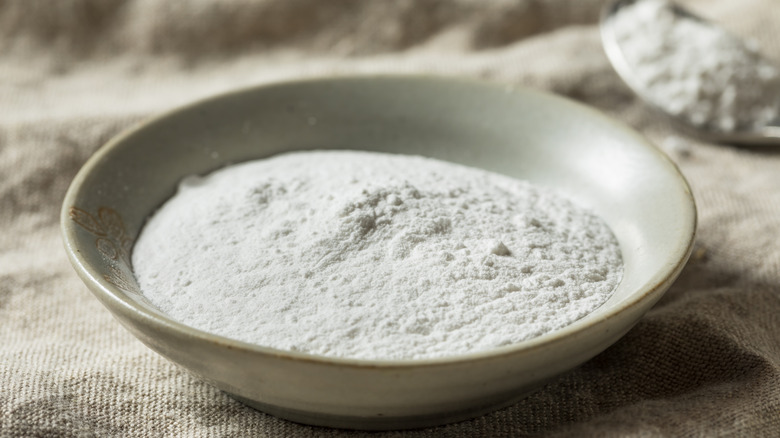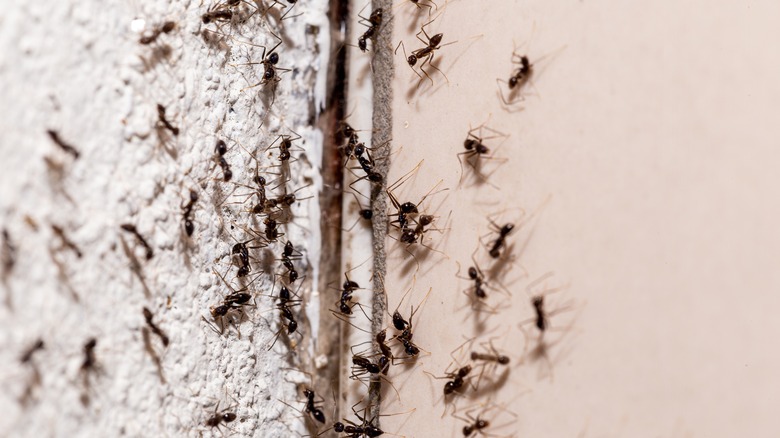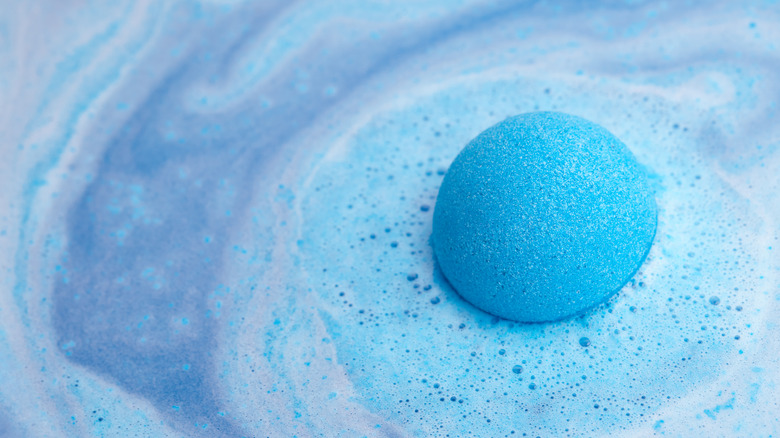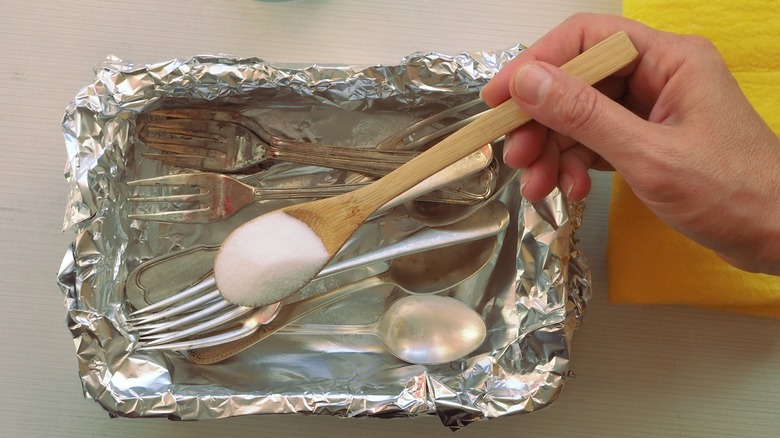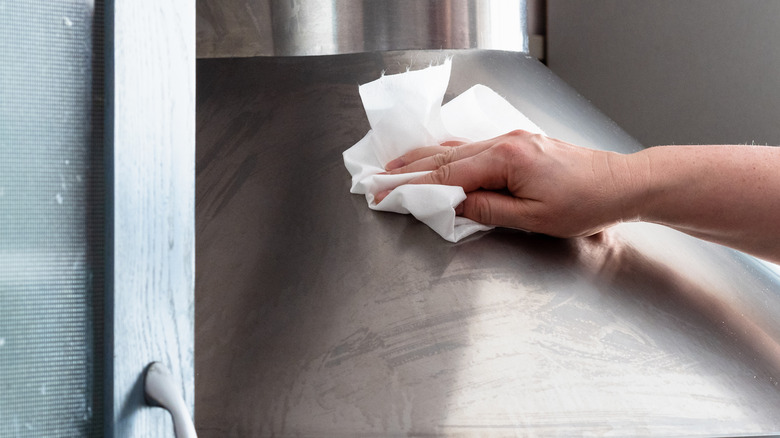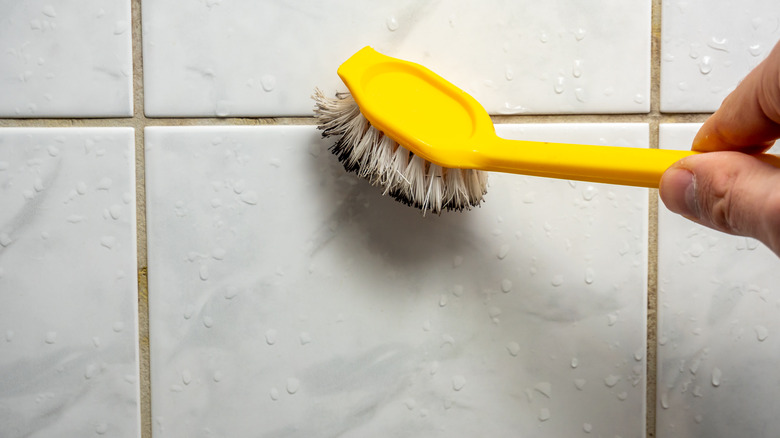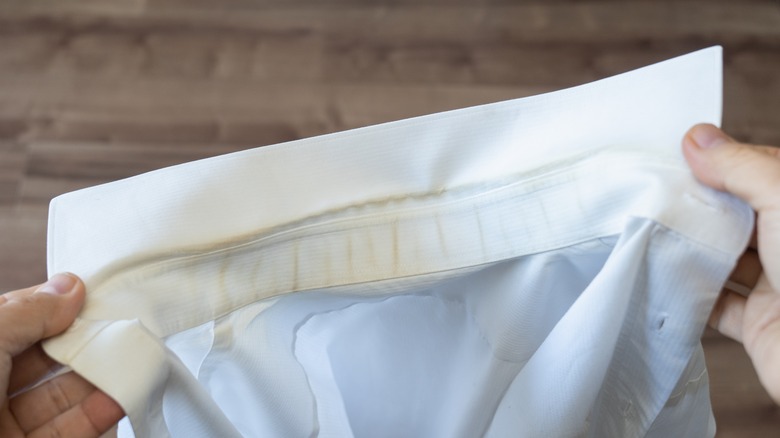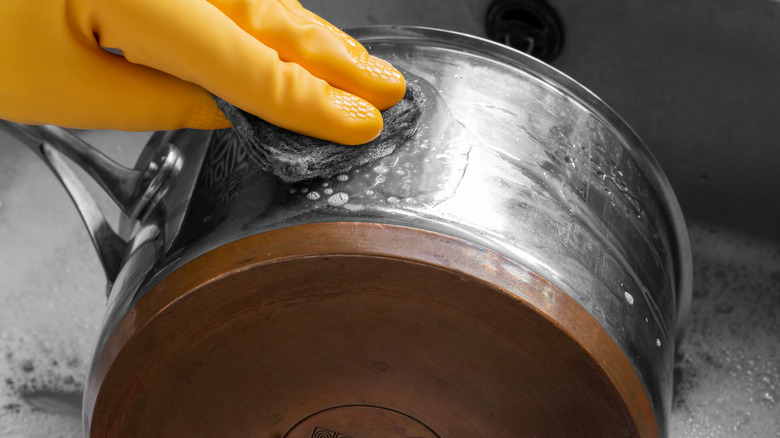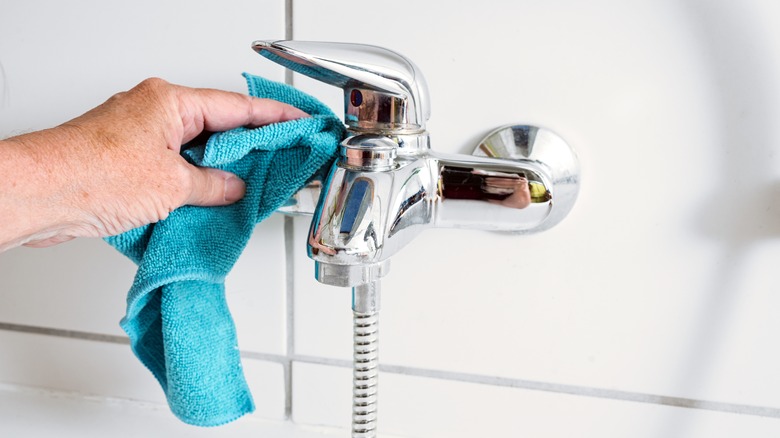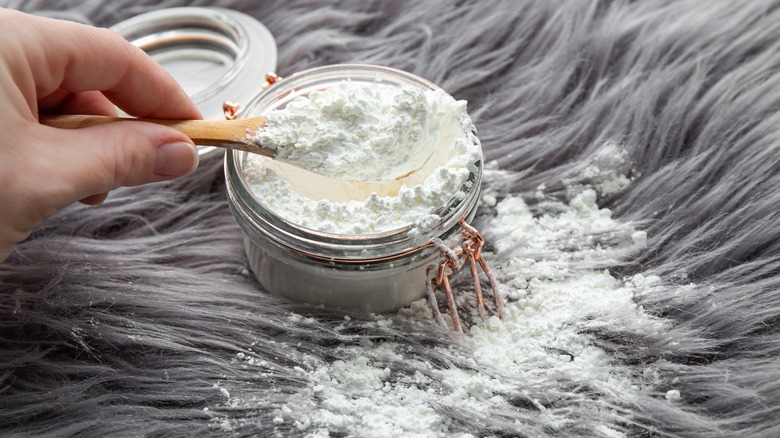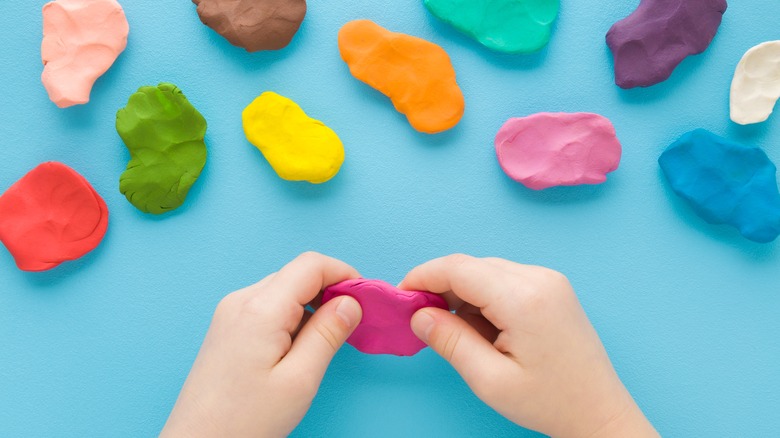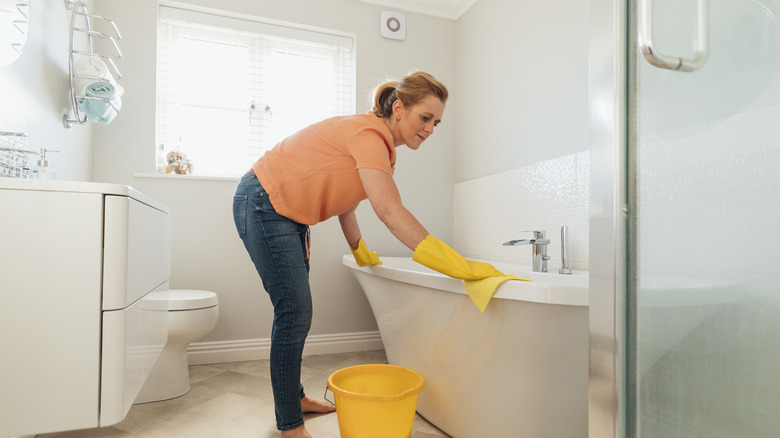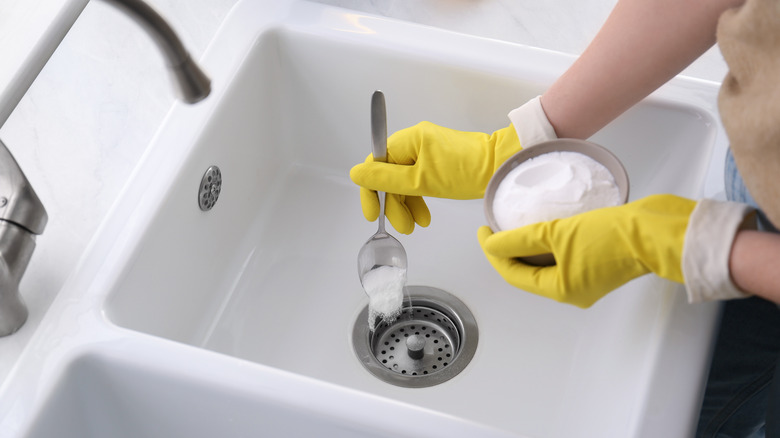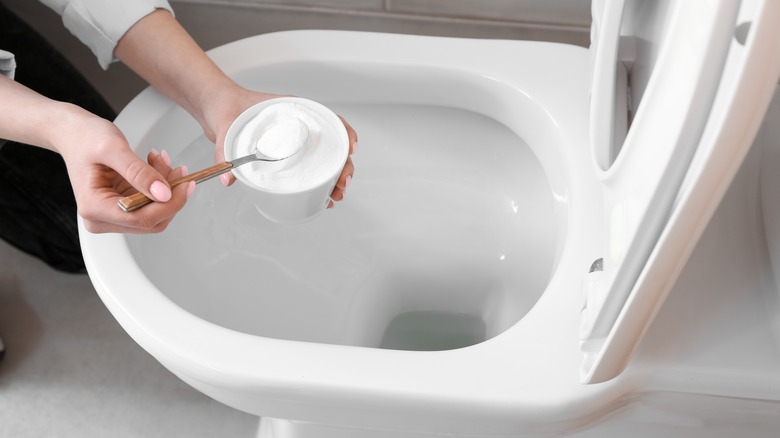14 Unexpected Uses For Cream Of Tartar Around Your Home
We may receive a commission on purchases made from links.
Cream of tartar, also known as potassium bitartrate, is a byproduct of the fermentation process in winemaking. It is popular among organic chemists for its role in illuminating three-dimensional molecular structures. However, it's probably more popular for its use in baked goods and confections, from snickerdoodle cookies to lollipops.
Cream of tartar tends to go straight from the baking aisle to the pantry (and typically in a teeny tiny jar) — but it has prolific, unexpected uses outside of the oven. It can be used as an all-purpose cleaner in the laundry room, bathroom, kitchen, and beyond. The powder can also be wielded for creative projects, pest control, and polishing. We're outlining the myriad uses for cream of tartar beyond its use in cooking or baking, so keep reading to learn how to put this unsung pantry powerhouse to work. You'll be wondering why you ever thought to buy it by the ounce instead of by the pound.
Deter ants by interrupting their pheromone trail
If you've ever had an ant infestation, you know how frustrating it can be to banish the little critters once and for all. The reason ants are so persistent when they get into your home is that they follow each other by a chemical pheromone trail. To turn the colony away from your home, the key is to disrupt that scent.
Luckily, the acidic makeup of cream of tartar gives off a smell that ants detest because it messes with their senses. To use cream of tartar for ant control, all you have to do is sprinkle a line where you notice the unwanted insects entering your home. Not only is this strategy simple and effective, but it also prevents the unnecessary use of harsh chemical insecticides in your home. It is worth noting that ingesting cream of tartar can be harmful to pets like cats and dogs, so you will want to make sure your furry friends don't have access to the area where it's being used.
Create a fizzy bath bomb
Citric acid is a popular ingredient that unites with baking soda to create the fizz effect in soap products like bath bombs. While citric acid is not so easy to find in your local grocery store, cream of tartar is. The baking aisle staple can stand in for citric acid to create a similar result. To make a bath bomb, start with a base of 2 parts baking soda to 1 part cream of tartar. One recipe from blogger The Makeup Dummy uses ½ cup baking soda and ¼ cup cream of tartar to yield three medium-sized bath bombs. But you can always adjust proportions depending on what size and how many bath bombs you'd like to make.
From there, add essential oils of your choice to scent the mixture. Dampen the powder ingredients further with a teaspoon of witch hazel or rubbing alcohol. If you want to dye your bath bomb, dilute a few drops of food coloring into the liquid at this step. Add fun extras like dried flowers. Finally, form the mixture into spheres using your hands, or press two small bowlfuls together for a professional, molded finish. Run a bath, plop it in, and enjoy the unexpected spa day, courtesy of cream of tartar.
Remove rust from kitchen utensils
If you've ever noticed small bits of rust on metal kitchen utensils or appliances, you may think you have to accept the unsightly splotches or replace the pieces altogether. But rust can actually be removed with the help of cream of tartar. When this ingredient is combined with water, its acidic properties are activated. This acidity can break down the structure of rust.
To put your cream of tartar to the test on rusty spots, combine the powder with a bit of water in a small bowl to create a paste. Spread the paste on the rust-affected area, and allow it to sit for five to 10 minutes. From there, use a microfiber cloth or small brush to buff away the rust in circles. You will see the dissolved rust wipe right off, leaving your utensils like new. It's worth noting that this hack probably won't be the most effective if you have an item that is severely rusted, but for small areas it works like a charm. We tested it ourselves and can confirm it works!
Polish your stainless steel appliances
Despite its name, stainless steel is still prone to spots and discoloration on the surface. Cream of tartar is not only acidic, but its powdery texture makes it slightly abrasive. This pantry staple can clean stainless steel by buffing out scuffs and scratches from your beloved appliances to make them shine again. If your coffee pot, toaster, or refrigerator needs some polishing, cream of tartar is an easy way to get the job done.
To get your stainless steel sparkling, all you will need is a microfiber cloth, the cream of tartar, and some water. Get the cloth damp, and then sprinkle some of the cream of tartar directly onto the cloth. Then, you can start buffing the stainless steel surface of your choice. Stainless steel has a grain to it, created during the manufacturing process, so to make your appliances look like new, buff the cream of tartar with the grain of the stainless steel instead of scrubbing randomly.
Make tile grout bright and fresh
If you've ever cleaned your bathroom and wondered why it doesn't quite seem as bright and fresh as it should, it's possible that discolored grout is to blame. Not all grouts are created equal, but cement grout, which is the most commonly used in home tiling projects, is porous by nature. And even if that grout has been sealed, sealant can break down over time — leaving your light-colored grout susceptible to staining.
If you thought you'd have to re-grout the tiles in your entire bathroom or kitchen to make them feel clean for good, don't fret. All you have to do is reach into the pantry for cream of tartar to get your grout sparkling white again. To get the most stain-fighting power out of the ingredient, combine it with white distilled vinegar to make a paste. Then, using a grout brush or even a spare toothbrush, work the paste into your grout, and watch it work like magic. Allow it to dry and then preserve its integrity by re-sealing with a product like Miracle Sealants Grout Sealer, which is sold at Lowe's for just $9.
Brighten discolored white shirt collars
If you've ever noticed discoloration on the collar of your beloved white button-up shirt, you're not alone. Commonly called "ring around the collar," this unsightly effect is caused by a buildup of sweat, dirt, and makeup in the neck area over time due to repeated wear. But before you bring out the bleach, try using cream of tartar to eliminate those stains around the collar of your closet's No. 1 workhorse.
To make your whites bright and clean once more, first dampen the affected area with water. Then sprinkle it with cream of tartar and massage it in. Allow it to sit for a couple of minutes before throwing the shirt in the washing machine. When combined with water, cream of tartar's acidity breaks apart the dirt and grime without being strong enough to damage the fabric itself. You can also use this method to get rid of pesky armpit stains!
Revive metal pots and pans
Metal pots and pans are versatile, essential kitchen staples that can last years on end if cared for properly. But it's inevitable that from time to time, your favorite cookware will need a thorough cleaning to keep performing its best. Whether you have a stainless steel saucier, an aluminum fry pan, a copper stock pot, or a brass saucepan, these common cooking materials can be made new again with the help of cream of tartar.
Aluminum cookware can be cleaned with cream of tartar by filling the pot or pan with water and 2 tablespoons of the powder, then bringing it to a boil for simmering for 10 minutes before washing and drying. To buff away scuffs, scratches, and small burn marks on brass or copper cookware, combine cream of tartar with lemon juice to make a paste. Apply it to your pots and pans, then let it sit for five minutes. Wash it off the warm water and dry it. The lemon's acidity will supplement the cream of tartar, helping to further break down culinary buildup.
Do away with hard water stains
When hard water stains build up on the bathtub and sink faucets, it may feel like they're never quite clean. That's because the stains are actually mineral deposits that build up over time. However, with a couple of household ingredients, it's easy to remove hard water stains from your bathroom surfaces.
Hydrogen peroxide and cream of tartar make a powerful pair in banishing both hard water stains and soap scum from your sink. Make a paste with equal parts of each ingredient, and allow it to sit on the stained area for 30 minutes. Once the grime is dissolved, simply wipe it away with a wet sponge. Need some extra scouring power? You can also use salt to clean hard water stains. This common pantry ingredient will add an abrasive oomph to the cream of tartar and hydrogen peroxide mix that is sure to break down the toughest buildup.
Remove fabric and carpet stains of any origin
Similar to its use for brightening whites, cream of tartar can also be used to lift a variety of stains from clothing and carpets. And the mess-busting benefits of cream of tartar can be applied in a number of different ways, with a number of different mixing agents, too. For example, the "Queen of Clean," Linda Cobb, recommends a mixture of cream of tartar and glycerine to create a shelf-stable stain removal spray to be applied to spots on clothes before laundering.
To tackle carpet stains with cream of tartar, try it with either lemon juice or hydrogen peroxide. Use enough of either liquid to make a paste with the cream of tartar, and allow it to soak into the soiled spot for 10 minutes. For older stains, you'll want to leave the paste on for longer. Cream of tartar has been proven to be effective for breaking apart both water-based and oil-based stains, but in general, oil-based stains tend to be tougher to remove from fabric. That said, let your mixture sit longer if you know the stain is from a greasy source, such as shoe polish or cooking oil.
Create your own fun with homemade Play-Doh
For all of its cooking and cleaning applications, making homemade Play-Doh is one of cream of tartar's more fun uses. Use the pantry ingredient to create a homemade play dough, perfect for kids' playtime (or for yourself — we're not judging!). By making the soft, pliable material at home, you'll save on costs (a single container of the name brand can cost upward of $5). If you make it yourself, you'll also be able to get extra creative by customizing the colors.
The recipe for this play dough comes from Jamielyn Nye, founder of the blog I Love Naptime. Start by combining 2 cups of flour, ¾ cup of salt, and 4 teaspoons of cream of tartar in a pot. Add 2 cups of water and 2 tablespoons of vegetable or coconut oil and stir constantly, cooking over medium heat.
Once the dough sticks together to form a ball, remove from the heat and transfer to a nonstick surface like wax paper. Once cooled, knead it until smooth, divide it up into small plastic bags, and then apply food coloring. Mix the color in by kneading with the dough inside of the bags to keep things mess-free, and store the dough in the bags to enjoy for about three months.
Refresh a porcelain bathtub
If you live in an older home, it's possible your bathroom may be outfitted with a porcelain enamel bathtub. Porcelain is a ceramic material that boasts low porosity and incredible durability in bathrooms (and other environments to boot). Namely, it is highly corrosion-resistant — to water, to alkaline substances, and to acids. But for all its durability, porcelain is still prone to damage and staining over time, especially if not properly cared for. The good news is that you can remove stains to refresh a porcelain tub yourself with common household ingredients.
The properties of porcelain that make it a great choice for a bathtub also mean that it will respond well to the use of acidic substances that happen to be tough on stains. To restore your porcelain tub to cleanliness without scratching or dulling the surface, use cream of tartar in combination with hydrogen peroxide. Make a paste-like mix with the two ingredients and apply it to the stains on your tub. After working it in and letting it dry, you should see those stains start to disappear. Clean with warm water and a cloth.
Rid dishes of scuff marks
Have you ever looked at your scratched up plates, bowls, and mugs, and thought they were beyond repair? Maybe you thought those gray lines were permanently etched into the dishware – but they are actually metal marks left behind by your utensils. It's likely that your scratched plates are made of porcelain or have porcelain enamel, and these "scratches" occur because the porcelain is characteristically harder than your silverware.
Keep your guests impressed with pristine dishes at your party by removing these marks with cream of tartar. All you need to do is make a paste with water and cream of tartar, apply it to the plate, and work it in until the marks disappear. Wash your plate off, and use a rag to buff it dry. Repeat the process as necessary, but you should only need one or two rounds max to get your dishes looking like new.
Unclog a backed-up drain
Unclogging a drain is one basic home improvement DIY project every homeowner should know how to do. If you're dealing with a backed-up sink or tub, first take some time to assess and address any large blockages, such as hair and debris buildup below your drain stopper. Pour boiling water into your drain and see if it clears it up. If that doesn't do the trick, you may be dealing with other buildup further along in your pipes. Before you bring in a plumber, you can make a last-ditch effort to unclog your drain with an unexpected household item: cream of tartar.
We already know that cream of tartar's acidity makes it great at breaking down grime. Mix together ½ cup baking soda, ½ cup salt, and ⅛ cup cream of tartar, and pour the mixture down the drain. You likely won't need to pour all of it down at once, so just start with half and reserve the rest for another time. Allow it to sit for 30 minutes to upward of an hour, and then flush it through with boiling water (use a tea kettle if you have one to make this step a breeze). As opposed to a harsh, store-bought chemical clog remover, this homemade drain cleaner is safer for both your plumbing and the environment. And with that said, it's best not to mess with plumbing too much before calling in the pros. If you're not having luck with a drain-safe home remedy, it may be time to call a plumber to take a look at the issue.
Get your toilet bowl squeaky clean
A clean toilet is a gateway to a beautifully clean bathroom. And you can avoid the intense scent of clinging bleach gel toilet cleaners to achieve pristine bathroom bliss. As an alternative, cream of tartar can get your toilet bowl sparkling. Sprinkle it around the bowl, allow it to sit for a minute or two, and then use your toilet brush to scrub the porcelain throne clean.
If you notice brown spots that aren't those brown spots, mineral buildup from your water supply is likely causing your toilet bowl stains. When cream of tartar isn't working well enough on its own to get rid of these marks, try scrubbing along with another cleaning agent, such as hydrogen peroxide, lemon juice, or distilled white vinegar. But caution – do not combine hydrogen peroxide and vinegar at the same time, as this mixture will cause the unwanted formation of a dangerous gas.
